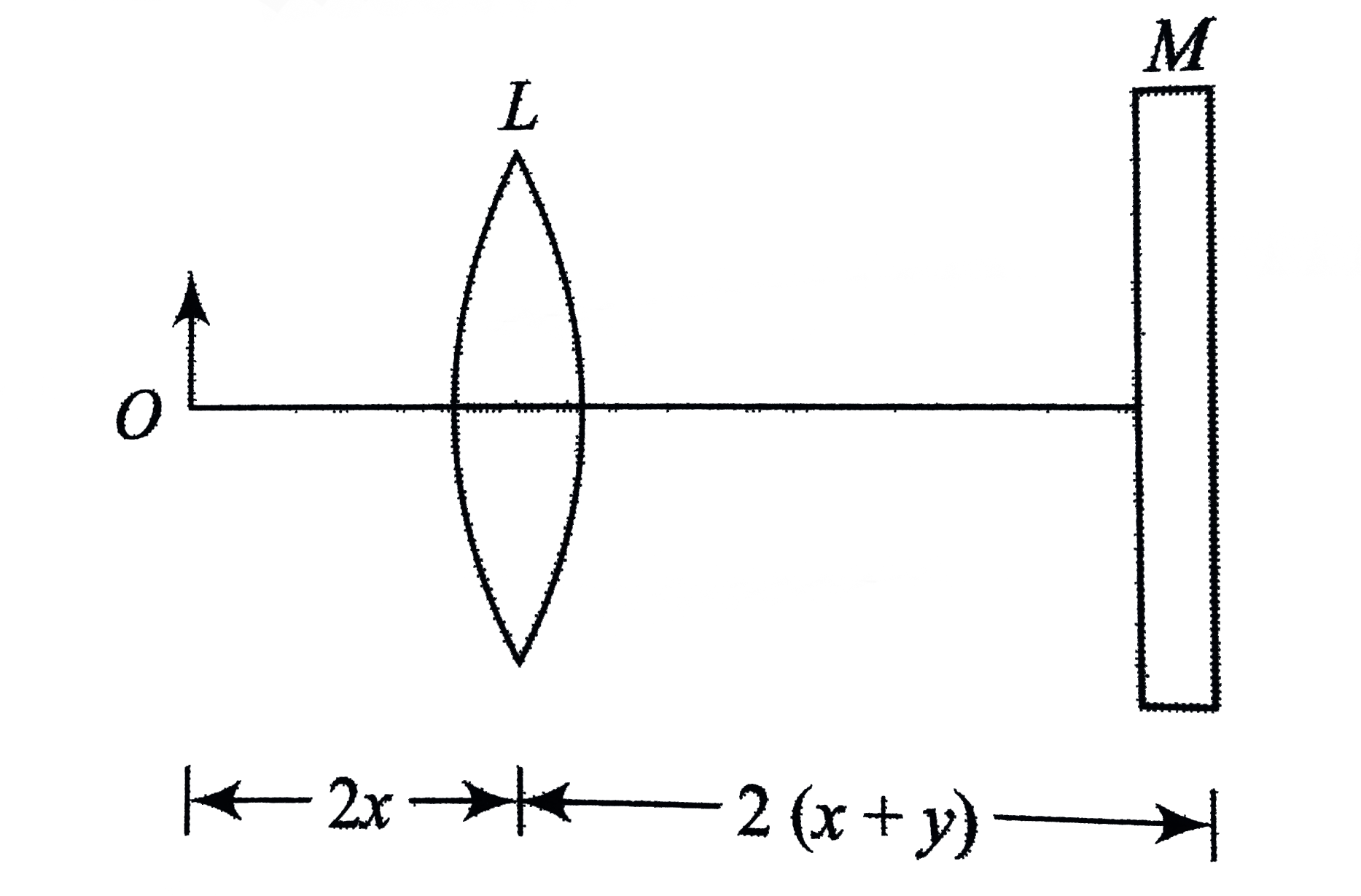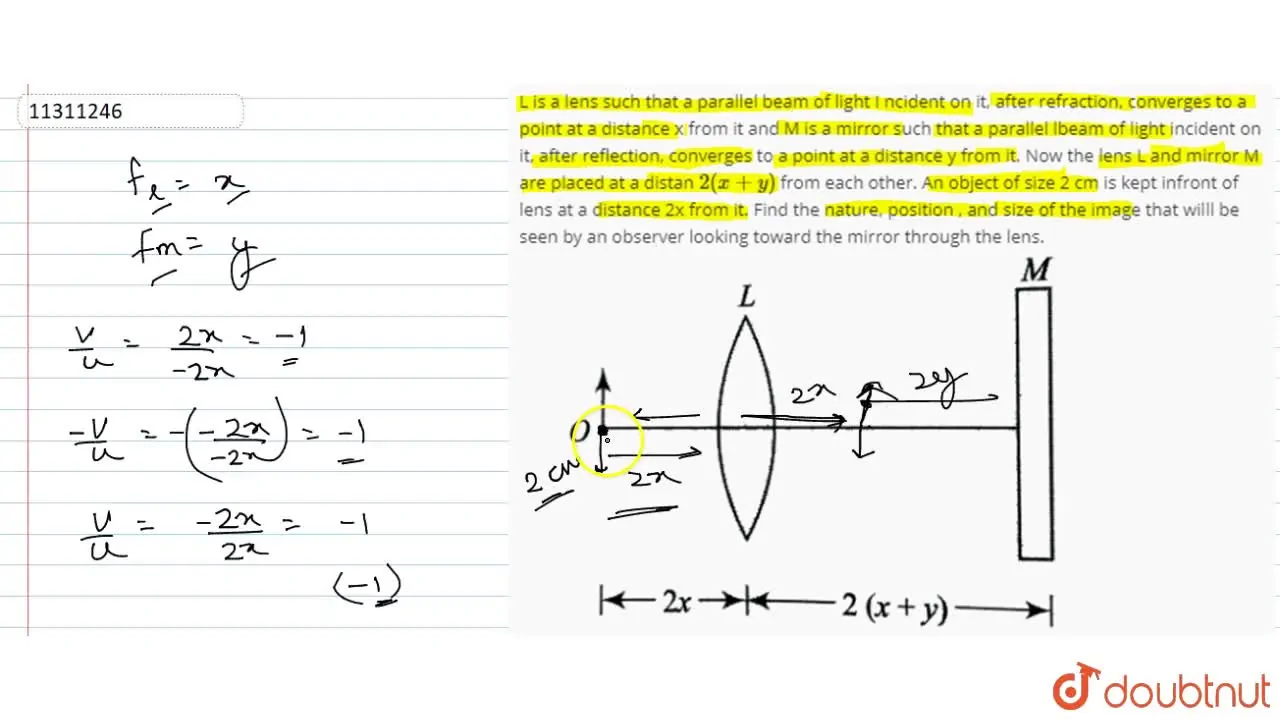L is a lens such that a parallel beam of light I ncident on it, after refraction, converges to a point at a distance x from it and M is a mirror such that a parallel lbeam of light incident on it, after reflection, converges to a point at a distance y from it. Now the lens L and mirror M are placed at a distan 2(x+y) from each other. An object of size 2 cm is kept infront of lens at a distance 2x from it. Find the nature, position , and size of the image that willl be seen by an observer looking toward the mirror through the lens.

It is given that a parallel beam incident on the lens, after refraction, converges to a point at a distance x from the lens. This implies that the focal length of the lens is x.
It is also given that a parallel beam incident on the mirror, after reflectino, converges to a point at a distance y from it. This implies that the mirror is a concave mirror of focal length y.
Obviously, object O is kept at 2F of lens L. Hence, its image I1 forms on the other side oat 2F , i.e., at distance 2x to the right of the lens. The image will be real, inverted, and magnification of this image m1=vu=2x−2x=−1 .
Image I1 of O formed by lens L acts as object for the mirror. Its distance from the pole of mirror will 2(x+y)−2x=2y . This implies that it will be at the center of curvature of the concave mirror (y being the focal length of the mirror). Therefore, the concave mirror forms a real, inverted (relative to I1) image I2 at the same position.
Magnification of I2 (relative to I1 ), m2=−1 . Finally, I2 acts as object for the lens. Its distance from thelens is 2x. Hence, it is at 2F of the lens (x being the focal length of the lens). Therefore, the lens will form a real and inverted image of I2 at 2F on the other side, i.e., to its left. Obviously, I3 will be at the same position as of the object.
Magnification of I3 (relative oto I2)=−1
Total magnification =m1×m2×m3=−1×−1×−1=−1
Thus, the final image is real and inverted and of the same size (2cm).
Complete reay diagram is shown in Figure.


Related Playlists
- BOOK - CENGAGE PHYSICSCHAPTER - GEOMETRICAL OPTICSEXERCISE - Solved Examples15videos
GEOMETRICAL OPTICS
- BOOK - CENGAGE PHYSICSCHAPTER - GEOMETRICAL OPTICSEXERCISE - Exercise1.114videos
GEOMETRICAL OPTICS
- BOOK - CENGAGE PHYSICSCHAPTER - FRICTIONEXERCISE - QUESTION BANK1videos
FRICTION
- BOOK - CENGAGE PHYSICSCHAPTER - GRAVITATIONEXERCISE - Question Bank39videos
GRAVITATION
Similar Questions
n a parallel beam of white light is incident on a converging lens, the colour which is brought to focus nearest to the lens is
View SolutionAfter reflection, the light rays from a point object at the focus of a concave mirror,
View SolutionIf a converging beam of light is incident on a concave mirror, the reflected light
View SolutionA converging beam of light incident on a lens emerges as a parallel beam. What kind of lens is it?
View SolutionWill the reflected rays converge at a point when a parallel beam of light is incident on a concave mirror of large aperture ?
View SolutionA convergent beam of light is incident on a convex mirror so as to converge to a distance 12 cm from the pole of the mirror. An inverted image of the same size is formed coincident with the virtual object. What is the focal length of the mirror
View SolutionA clear transparent glass sphere (μ=1.5) of radius R is immersed in a liquid of refractive index 1.25. A parallel beam of light incident on it will converge to a point. The distance of this point from the center will be
View SolutionA parallel beam of light is incident on a converging lens parallel to its principal axis. As one moves away from the les on the other side on its principal axis, the intensity of light
View SolutionA convex lens of focal length 1.0m and a concave lens of focal length9.25m are 0.75m apart. A parallel beam of light is incident on the convex lens. The beam emerging after refraction from both lenses is
View SolutionAfter reflection, the paralle beam of light appears to come from a point then the type of mirror is ______
View Solution


